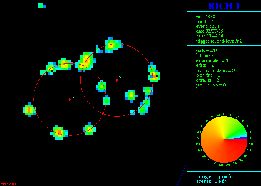
Physics Programme
CERES spectrometer, setup 1998


 Cherenkov rings in RICH-1 in p-Be collision at 450 GeV/c (left picture)
Cherenkov rings in RICH-1 in p-Be collision at 450 GeV/c (left picture)
Tracks in the new TPC of CERES in Pb-Au collision at 158A GeV/c (right picture)

CERES Physics Programme
CERES (CErenkov Ring Electron Spectrometer) is an experiment dedicated to
the measurement of low-mass (m < 1.5 GeV/c2)
electron pairs and direct photons
emitted in ultra-relativistic heavy-ion collisions at the CERN SPS. These observables are considered
useful probes of the dynamics of the collisions and in particular the early stages,
where the conjectured phase transition(s) are expected to take place.
CERES has completed a systematic physics programme, including the measurements
of electron pairs in p-Be (a very good approximation to p-p collisions) and
p-Au collisions ad 450 GeV/c, S-Au collisions at 200A GeV and Pb-Au
collisions at 158A GeV. An interesting result has emerged from this study, namely the
observation of a strong enhancement of low-mass pairs in S and Pb
induced collisions, whereas no enhancement was observed in p-Be and
p-Au collisions. The onset of the excess, starting at a mass of m~2m
 , suggests the opening
of the two-pion annihilation channel
, suggests the opening
of the two-pion annihilation channel  +
+ -
-> e+e-. This would then be the
first evidence of thermal radiation emitted by dense hadronic matter formed in
relativistic heavy-ion collisions. The CERES results have triggered
intensive theoretical activity. The debate is mainly stimulated by the possibility that
the excess originates from in-medium modifications of the vector meson properties -
of the
-
-> e+e-. This would then be the
first evidence of thermal radiation emitted by dense hadronic matter formed in
relativistic heavy-ion collisions. The CERES results have triggered
intensive theoretical activity. The debate is mainly stimulated by the possibility that
the excess originates from in-medium modifications of the vector meson properties -
of the  -meson in particular - and may hint to the
restoration of chiral symmetry.
-meson in particular - and may hint to the
restoration of chiral symmetry.
To further elucidate this interesting possibility CERES has recently completed a major
upgrade of the apparatus with the addition of a radial
TPC
behind the double
RICH
spectrometer. The goal is to considerably improve the mass resolution of the
spectrometer to the level of  m=2% at
m=1 GeV/c2, such that possible mass shifts or changes in
width of the vector mesons
m=2% at
m=1 GeV/c2, such that possible mass shifts or changes in
width of the vector mesons  ,
,
 and
and
 can be directly observed.
can be directly observed.
The TPC is fully operational. A first run with Pb beam at the lowest energy available at CERN,
i.e. 40 GeV/c per nucleon, took place in the fall of '99 and a run at the full energy of 158 GeV/c
per nucleon is planned in the fall of the year 2000.

CERES Experimental Setup

Who was Ceres after all? A mythological digression

Ilia Ravinovich
Last modified: Tue Apr 4 15:46:09 IST 2000



 Cherenkov rings in RICH-1 in p-Be collision at 450 GeV/c (left picture)
Cherenkov rings in RICH-1 in p-Be collision at 450 GeV/c (left picture) 


